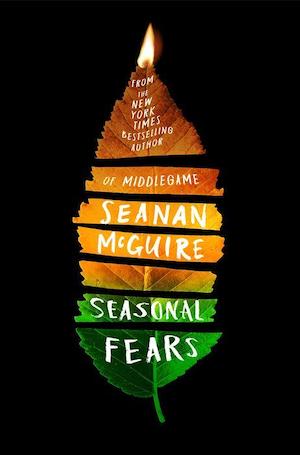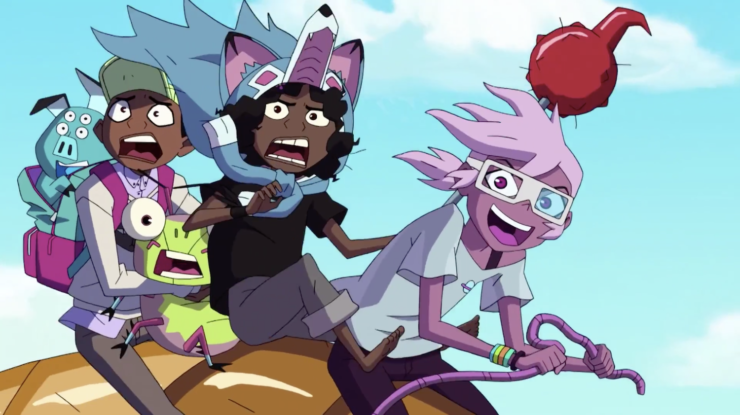Imagine Netflix’s recommendation algorithm as a dragon dozing atop its hoard of treasures. The dragon sleeps, listlessly dreaming of new opportunities to add to its already massive collection. Beneath it, a treasure trove of content beckons, tempting knights in shining armor or crafty rogues to pilfer the gems hidden beneath it. And once in a while, the knights succeed: Squid Game, The Queen’s Gambit, The Witcher, and Tiger King all emerged from the hoard, skyrocketing to record viewership.
But for every viral hit, there’s a whole cavalcade of worthy shows that don’t break into the mainstream and find the audience they deserve. Instead, these shows are relegated to relative obscurity, lost in shadow beneath the dragon’s slumbering form.
Enter Kipo And the Age of Wonderbeasts, an animated post-apocalyptic sci-fi/fantasy hybrid that never escaped from the dragon’s cave (or at least, not yet…).
Netflix released three 10-episode seasons over the course of 2020 to little fanfare, then the series sunk back into the depths of the Netflix content machine. And that’s unfortunate, because more than a year removed from its final episode hitting the streaming service, Kipo remains a charming, thoughtful, and endlessly watchable story.
Radford Sechrist created the series, based on his webcomic Kipo. Dreamworks produced the series, though it was animated (with a distinct style, I might add) by Studio Mir of South Korea. Add in the diverse cast and crew (more on that in a bit), strong representation of historically underprivileged communities, and a sharp three-season narrative arc, and you’ve got a recipe for success.
At least, in theory. As I hinted above, Kipo earned precious little time in the limelight, if any at all. Frankly, it’s a shame. Rarely have I encountered a show with such a strong sense of identity and a clear goal in mind. Kipo shines where other animated stories fizzle. The show brings fresh ideas to the fantasy and sci-fi world with unique perspectives on what it means to be different, the importance of accomplishing tasks through teamwork, and finding nonviolent (and often musical) solutions to problems. The world and characters bolster these themes, making Kipo the real deal—a show that feels genuine, and is genuinely entertaining.
Episode one opens on a broad shot of a nameless metropolis. Then a cut to the same metropolis, now overrun with plants and reclaimed by nature. The camera pans down, revealing we’re on the outskirts of the city, near a dried-up riverbed. The screen shakes and rumbles until a nearby aqueduct spews a deluge of water and debris into the channel, carrying with it a young woman with pinkish-purple skin and a blue jumpsuit. Kipo’s first words tell us what we’re in for right away: “I’m on the surface!” she says, panicked. She repeats herself, then doubles down on her panic after looking directly into the sun and worrying it will blind her.
Immediately, we discover that Kipo has emerged (against her will) from her underground burrow, where a community of humans has been living below the surface for an uncertain amount of time. Mutated animals (“mutes”) now inhabit the surface. Some mutes have developed sentience. Others remain bestial, serving as analogs to creatures we’d be familiar with (though they’ll usually come with bonus eyes or appendages; it’s the future, after all). Then there are mega-mutants—gargantuan animals that can grow as large as skyscrapers. Forced from her home, Kipo has to brave the unknown to find her fellow burrow-dwellers.
Buy the Book


Seasonal Fears
Kipo soon befriends two human surface-dwellers: Wolf, a hardened “I prefer to work alone” type with a mysterious past, and Benson, a friendly guy who wanders the surface with his mutant companion, Dave. Dave’s a sentient bug who metamorphosizes to different life stages at inopportune moments; he’s also hands-down the funniest character in the series, if you ask me. Rounding out the squad is Mandu, a blue, four-eyed, six-legged pig, and not a meal, as Kipo must remind Wolf a few times.
This is our Team Avatar, if you’ll forgive the comparison, and they’re a wonderful crew to spend a show with. Each brings something to the table by way of strength, but they’re all hiding demons. Kipo and her crew operate like a well-balanced D&D party. Their connections grow over time, but I won’t dare spoil any of the delightful character development to come. Besides the basic premise and bits and pieces of the first episode’s plot, I’ve only scratched the surface (pun intended) in terms of what Kipo has to offer, here. There are myriad spoiler-free reasons the show is worth a watch.
The first is Kipo’s sheer originality. Speculative fiction fanatics have plenty of post-apocalyptic tales to choose from, but Kipo pays homage to the genre while exploring new ground. The show has musical elements that sets it apart, permeating the entire viewing experience and tying the story, characters, and world together into a cohesive whole. Kipo herself is a bit of a bard. She sings, plays guitar, and prefers to solve her problems using music and diplomacy. The mutant factions she meets—dubstep bees, science-obsessed Newton wolves, Timbercats (lumberjack felines, and they’re adorable), hard-rock rattlesnakes, fitness-fanatic raccoons, and many others—shine with unique visual and musical styles.
In case I’m not being perfectly clear, many of Kipo’s 30 episodes feature a song in some form. The soundtrack of the show cements its identity as a cohesive work of art, melding diverse modern music with the show’s distinct artistic flair. To watch Kipo is to experience the culmination of countless talents, all working together to achieve an overall vibe. The show succeeds in summoning smiles at every turn by presenting you with a thoughtful combination of artistic elements served with a healthy measure of childish wonderment. Before I make my next point, here’s a minuscule sampling of the musical goodness on offer in Kipo. It’s the main title music, ringing in each new episode with a jaunty, positive song snippet:
Second, Kipo and the Age of Wonderbeasts is a non-stop celebration of diversity. The soundtrack (you can stream mixtapes for each season on Apple Music, Spotify, and other services) boasts an impressive roster of creators and musicians lending their tunes to the show. The voice cast includes Karen Fukuhara, who you may know from Suicide Squad and The Boys, as Kipo, along with Sydney Mikayla (Wolf), Deon Cole (Dave), and Coy Stewart (Benson). My favorite overall performance comes from Sterling K. Brown as Kipo’s father, Lio. The show has also been lauded (rightfully so) for its LGBTQ+ representation, and the arc of the character in question is a season one highlight, handled in a way that’s both touching and refreshingly casual. All-in-all, Kipo clearly treats its cast and characters with respect, creating a warm, positive space for the underrepresented and telling stories we haven’t always seen or heard in popular media. Kipo feels new and groundbreaking in a way show few shows manage, in large part due to the deliberate care the show took to give its diverse cast and production team a platform to share their ideas.
Finally—and I hinted at this above—Kipo explores deep philosophical themes. The show is geared toward tweens, so be prepared for the occasional hamfisted message. But for the most part, Kipo packages its lessons in meaningful story beats. As Kipo earns the trust of her new friends, they start to understand her methods and slowly come around to her way of thinking. Kipo is more inclined to sing a song about unity than to demolish and discard someone who’s in her way or who may first appear to be a foe. She listens and plays an active role in understanding the plights of the people and mutants she meets. It doesn’t always work, and she has Dave and Wolf for those moments when diplomacy fails—but if there’s a way to surmount a problem without fists and feet, Kipo will find it. These moments hit hardest later in the series. For spoilerific reasons, I won’t say get into details, but suffice it to say Kipo comes into some rather destructive power. When she sets her abilities aside in favor of diplomacy, the show affirms and cements its identity as something new, something different. Something that deserves our attention.
Its diverse, talented cast, brilliant sheen of originality, and deft exploration of worthy themes make Kipo a must-see. Though it flew under the radar during its gradual 2020 release, the show holds up, and will hopefully continue to find its fans. Kipo asks questions other shows won’t, and it offers an optimistic worldview in a time that desperately needs one. If you’re not already part of the Kipo fanbase, I hope you’ll consider joining our ranks. And in the meantime, I’ll leave you with one more musical clip from the show as send-off: “What We Have Is You.”
Cole Rush writes words. A lot of them. For the most part, you can find those words at The Quill To Live or on Twitter @ColeRush1. He voraciously reads epic fantasy and science-fiction, seeking out stories of gargantuan proportions and devouring them with a bookwormish fervor. His favorite books are: The Divine Cities Series by Robert Jackson Bennett, The Long Way To A Small, Angry Planet by Becky Chambers, and The House In The Cerulean Sea by TJ Klune.










